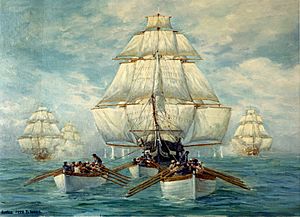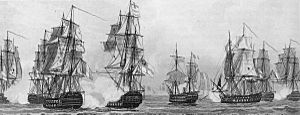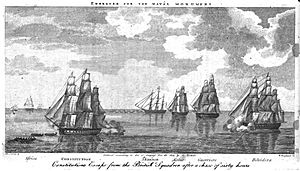HMS Aeolus (1801) facts for kids
Quick facts for kids History |
|
|---|---|
| Name | HMS Aeolus |
| Ordered | 28 January 1800 |
| Builder | Mrs Frances Barnard, Deptford |
| Laid down | April 1800 |
| Launched | 28 February 1801 |
| Completed | By 10 April 1801 |
| Honours and awards |
|
| Fate | Broken up in October 1817 |
| General characteristics | |
| Class and type | 32-gun Amphion-class fifth-rate frigate |
| Tons burthen | 91876⁄94 (bm) |
| Length |
|
| Beam | 37 ft 8 in (11.5 m) |
| Depth of hold | 12 ft 6 in (3.8 m) |
| Propulsion | Sails |
| Sail plan | Full-rigged ship |
| Complement | 254 |
| Armament |
|
HMS Aeolus was a 32-gun frigate of the Royal Navy. She was launched in 1801. This ship served during the French Revolutionary Wars, Napoleonic Wars, and the War of 1812.
Aeolus first helped protect convoys of ships. Later, she sailed to the West Indies and helped blockade French ships. She was part of the chase and capture of the French ship Duquesne. Aeolus then returned to British waters. In 1805, she joined Sir Richard Strachan's squadron. This group found and captured four French ships that had escaped the Battle of Trafalgar.
Later, Aeolus was in the Caribbean in 1809. She took part in the capture of Martinique. During the War of 1812, she helped capture USS Nautilus. This was the first ship lost by either side in that war. Aeolus also chased USS Constitution and captured an American privateer called Snapper. After the wars, she became a storeship in Quebec. Aeolus was eventually taken apart in 1817.
Contents
Building and First Commander
Aeolus was ordered on January 28, 1800. She was built by Mrs. Frances Barnard in Deptford, England. The ship was laid down (meaning construction began) in April 1800. She was launched into the water on February 28, 1801.
In March 1801, Aeolus was ready for service. Her first commander was Captain John Spranger. Aeolus was the third ship in the Royal Navy to have this name. The first Aeolus (launched in 1758) was renamed Guernsey in 1800. This made the name free for the new ship. Another French frigate, Pallas, was captured and also named Aeolus. But then the first Guernsey was sold. So, the second Aeolus was renamed Pique. This meant the new ship could keep the name Aeolus.
Ship's Service
West Indies Missions
Aeolus first worked on convoy duties. She sailed to Jamaica in January 1802. In May 1803, Captain Andrew Evans took command.
On February 1, 1804, Aeolus captured an American ship called Antelope. This ship was carrying supplies and goods. In May 1804, Lord William FitzRoy became her commander.
Aeolus joined Commodore John Loring's squadron. They were off Saint-Domingue (now Haiti). On July 25, 1804, Aeolus helped capture the French ship Duquesne. Duquesne was a large 74-gun ship. She had been trapped by a British blockade at Cape Francois.
The French ships escaped on July 24. They split up. Duquesne headed west. British ships, including Aeolus, chased her. Duquesne could not get away and surrendered.
Battle of Cape Ortegal
After this, Aeolus was sent to patrol the English Channel. By late 1805, she was part of Sir Richard Strachan's squadron. They were in the Bay of Biscay. This squadron was looking for a French group of ships.
On November 3, they met HMS Phoenix. Its captain reported escaping from four large French ships. Strachan immediately went after them. These were not the ships they were looking for. Instead, they were four French ships that had escaped the Battle of Trafalgar. They were trying to reach Rochefort.
The French admiral tried to get away. But the British ships were faster. Strachan sent the quicker frigates, including Aeolus, to attack the French ships at the back. Aeolus helped attack the French ship Scipion. As the bigger British ships arrived, the French were surrounded. All four French ships had to surrender. Aeolus had no one killed and only three wounded in this battle. Years later, in 1847, a special medal was given to those who fought in this action.
Service in Ireland and America
Aeolus spent 1805 and 1806 off the coast of Ireland. In August 1807, she sailed to Halifax. She then went to the Caribbean. In February 1809, she helped capture Martinique. Aeolus was part of a small group of ships that entered Fort-de-France Bay. The French defenders panicked and set their own ships on fire. They also left their forts. In 1847, another medal was given for those who served in the Martinique campaign.
After five years, Captain Fitzroy left Aeolus in October 1809. Captain John Shortland took command. Then Captain Lord James Townshend took over in December 1810. A famous author, Frederick Marryat, served on Aeolus in 1811.
War of 1812 Actions

When the War of 1812 began, Aeolus joined Captain Philip Broke's squadron. On July 15, she helped capture the American ship USS Nautilus. This was the first ship lost by either side in the war. The British squadron was looking for another American ship, but it had already left.
Instead, they found Nautilus. She could not escape the British ships and surrendered. Soon after, the squadron found USS Constitution. They chased her for three days. The American ship threw things overboard to lighten herself. She was even towed and pulled by ropes to get away. Finally, she managed to escape.
On November 3, 1812, Aeolus and other British ships captured the American privateer Snapper. Snapper was a ship from Philadelphia with ten guns. American newspapers said she took many shots before surrendering.
On August 7, 1812, Aeolus captured and burned the American ship Pomona. Pomona was sailing from Liverpool to an American port.
Between February and March 1813, Aeolus captured several American merchant ships. She also captured one Spanish ship. These ships were sent to Bermuda. They were carrying goods like molasses, cotton, rice, and flour.
After these captures, Captain Joseph Popham took command of Aeolus in 1813. Commander James Crighton then took over in 1814.
End of Service
Aeolus was sent to Quebec to be a storeship. This means she was used to hold supplies. In August 1814, she returned to Britain. She was laid up (put out of service) at Woolwich. In June 1816, she moved to Deptford. Finally, in October 1817, Aeolus was broken up there.



